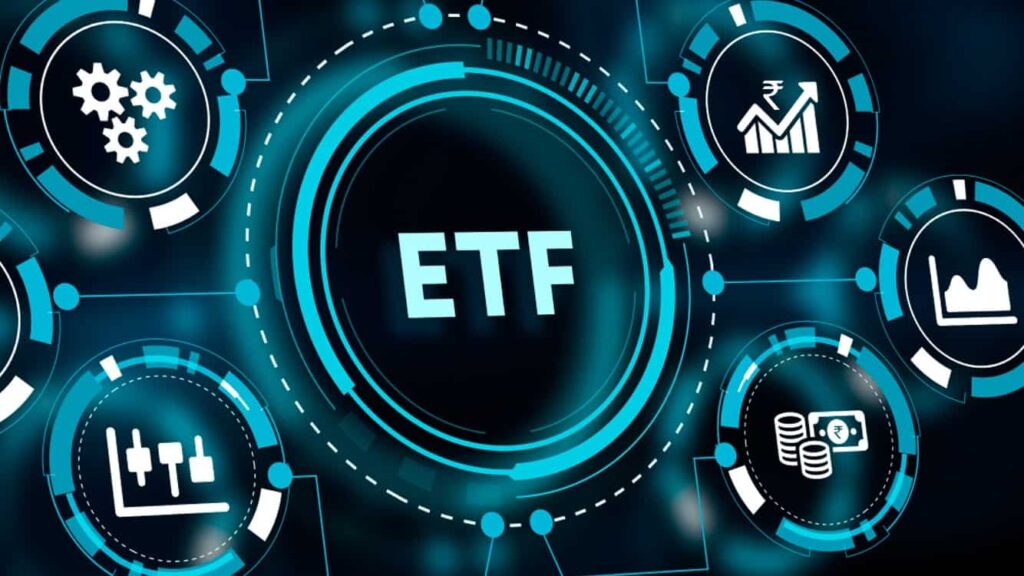
Introduction
Evolution and Impact of Exchange-Traded Funds (ETFs): Are innovative investment vehicles that offer investors a flexible and cost-effective way to gain exposure to various asset classes, sectors, and investment strategies (Ostrowski, 2019). Unlike traditional mutual funds, ETFs trade on stock exchanges, providing investors with intraday liquidity and transparency (Bai et al., 2020). Since the launch of SPY in 1993, the ETF industry has grown exponentially in both assets under management (AUM) and product diversity (Cremers & Weinbaum, 2021).
This research article provides a comprehensive analysis of ETFs. By covering their evolution, structure, and market impact, this paper will shed light on the significant role ETFs play in shaping modern investment practices.
Evolution of Exchange-Traded Funds (ETFs)
Evolution and Impact of Exchange-Traded Funds (ETFs): were created to provide investors with a more efficient and accessible way to invest in diversified portfolios (Edelen et al., 2017). The concept of ETFs originated with the introduction of Index Participation Shares (IPS) in the 1980s. These early ETFs eventually evolved into the first true ETF, the SPDR S&P 500 ETF (SPY), which was launched by State Street Global Advisors in 1993 (Khorana & Servaes, 2019). Since then, the ETF industry has experienced significant growth, with a wide range of ETFs available that cover various asset classes, including stocks, bonds, commodities, and alternative investments (Edelen et al., 2017).
The development of ETFs has been heavily influenced by regulatory changes. The Securities and Exchange Commission (SEC) has established a regulatory framework that governs the creation, operation, and disclosure requirements of ETFs (Benson et al., 2020). A key regulatory milestone was the adoption of Rule 6c-11, which streamlined the process for launching ETFs and improved transparency for investors (Bai et al., 2020).
Performance and Efficiency of ETFs
Outperforming Traditional Options
Numerous studies have compared ETFs to traditional mutual funds and benchmark indices in terms of performanceand efficiency (Cremers & Weinbaum, 2021). Generally, ETFs boast several advantages:
- Lower Costs: ETFs typically come with lower expense ratios compared to mutual funds (Ostrowski, 2019). This means investors keep more of their returns.
- Tighter Spreads: Bid-ask spreads, the difference between buy and sell prices, tend to be tighter for ETFs, reducing transaction costs (Ostrowski, 2019).
- Tax Efficiency: The structure of ETFs often leads to greater tax efficiency compared to mutual funds (Ostrowski, 2019).
- Competitive Returns: ETFs have delivered competitive risk-adjusted returns, especially when tracking broad market indices (Bai et al., 2020). They have also demonstrated a lower tracking error, meaning their market price stays closer to their underlying NAV.
Impact on Financial Markets
A Double-Edged Sword: ETFs and Market Dynamics
ETFs have undeniably impacted financial markets, influencing factors like price discovery, market integration, and even volatility (Cremers & Weinbaum, 2021). Here’s a closer look at both the positive and negative effects:
Positives:
- Enhanced Efficiency: The arbitrage mechanism embedded in ETFs helps align market prices with the underlying value of the securities (Ostrowski, 2019). This promotes a more efficient market.
- Risk Sharing: ETFs facilitate the transfer of risk across market participants, contributing to overall financial market stability (Bai et al., 2020)
- Concerns:
- Volatility Spike Potential: Some experts worry that ETFs, particularly in less liquid markets, could exacerbate volatility during periods of stress (Khorana & Servaes, 2019).
- Systemic Risk: The rapid growth of leveraged and inverse ETFs has raised questions about their potential impact on market dynamics and the possibility of increased systemic risk (Edelen et al., 2017).
ETFs and Portfolio Management – A Game Changer
Exchange-Traded Funds (ETFs) have revolutionized portfolio management, empowering investors with a wealth of options and strategies (Cremers & Weinbaum, 2021). Let’s explore how ETFs have become a game changer:
- Diversification Made Easy: ETFs offer a convenient way to achieve broad diversification across asset classes, sectors, and even geographic regions (Bai et al., 2020). This helps investors spread risk and build a more resilient portfolio.
- Flexibility for Strategy: The liquidity and variety of ETFs make them ideal for implementing various investment strategies.
- Asset allocation becomes efficient, allowing investors to tailor their exposure to different asset classes.
- Sector rotation and tactical allocation strategies benefit from ETFs’ flexibility, enabling investors to adapt to changing market conditions (Ostrowski, 2019).
- Risk Management Arsenal: ETFs can be powerful tools for risk management. Investors can utilize them for:
- Hedging existing holdings to mitigate potential losses.
- Downside protection strategies to safeguard portfolios during market downturns (Khorana & Servaes, 2019).
Investor Behavior and the ETF Boom
The rise of ETFs can be attributed to several factors that resonate with investors:
- Cost Advantage: ETFs generally boast lower expense ratios compared to mutual funds, allowing investors to keep more of their returns (Edelen et al., 2017).
- Transparency: ETF holdings are readily available, providing investors with clear insight into what they’re buying.
- Liquidity Advantage: Unlike mutual funds with a single daily price, ETFs trade throughout the day, offering investors greater flexibility.
This transparency and ease of use have fueled ETF adoption, particularly among:
- Millennials and Gen Z: These demographics value the simplicity, flexibility, and often digital accessibility of ETFs (Bai et al., 2020).
However, investors should be aware of potential behavioral pitfalls:
- Herding Behavior: The tendency to follow the crowd can lead investors to blindly invest in popular ETFs without proper research.
- Performance Chasing: Chasing past returns can be a recipe for disappointment, and ETFs are not immune to this behavioral bias (Cremers & Weinbaum, 2021)
Challenges and Opportunities for ETFs
The Road Ahead: Challenges and Opportunities
While ETFs have become a cornerstone of investing, they are not without their challenges:
- Regulatory Scrutiny: Regulators are keeping a watchful eye on areas like transparency, disclosure practices, and potential manipulation within the ETF ecosystem (Edelen et al., 2017).
- Structural Concerns: The rise of complex and less-liquid ETF products raises questions about their ability to withstand market downturns (Bai et al., 2020).
However, these challenges also present opportunities for the ETF industry to evolve:
- Innovation and Growth: The future holds promise for innovation in ETF design and functionality within the asset management landscape (Cremers & Weinbaum, 2021).
- Technological Advancements: Technologies like blockchain and artificial intelligence have the potential to revolutionize ETF trading and settlement, further improving efficiency and transparency (Ostrowski, 2019).
Future Trends and the Evolving Landscape of ETFs
The future of ETFs is bright, driven by several key trends:
- Continued Growth: Demand for passive investing, thematic strategies, and sustainable investing is expected to propel further ETF growth (Khorana & Servaes, 2019).
- Regulatory Evolution: Regulatory reforms focused on transparency and investor protection will likely influence the direction of ETFs, solidifying their position within the investment landscape (Bai et al., 2020).
- Product Innovation: The potential convergence of ETFs with derivatives and structured products opens doors for innovative products and cross-asset hedging strategies (Edelen et al., 2017).
- Emerging Asset Classes: The rise of digital assets and cryptocurrencies has paved the way for ETFs tracking these alternative investments, offering investors exciting new avenues for diversification and risk management (Cremers & Weinbaum, 2021).
Implications for Investors:
These trends suggest that ETFs will remain a significant force in the investment world. Investors can benefit by:
- Staying Informed: Keeping pace with regulatory developments and emerging trends in the ETF universe.
- Conducting Thorough Research: Carefully evaluating specific ETFs before making investment decisions.
- Understanding Investment Goals: Selecting ETFs that align with their long-term financial objectives.
Conclusion: ETFs – A Powerful Tool for Modern Investors
Exchange-Traded Funds (ETFs) have revolutionized investing, offering a powerful tool for building diversified portfolios. Here’s a recap of their impact:
- Investor Benefits: Easy access to a wide range of assets, lower costs, and greater transparency compared to traditional options (Ostrowski, 2019).
- Market Impact: Increased efficiency, liquidity, and price discovery through mechanisms like arbitrage (Bai et al., 2020).
- Portfolio Management: Streamlined diversification, flexibility for various investment strategies, and risk management techniques (Khorana & Servaes, 2019).
The future of ETFs is promising, with potential for further growth, innovation, and convergence with new asset classes (Cremers & Weinbaum, 2021). However, navigating the ETF landscape requires ongoing education and a disciplined approach. Investors who stay informed, conduct thorough research, and align their ETF choices with long-term goals will be well-positioned to succeed in today’s dynamic financial environment (Edelen et al., 2017).
References
– Bai, J., Chang, E. C., & Wang, X. (2020). “Exchange-Traded Funds (ETFs) and Asset Pricing Anomalies.” Review of Finance, 24(1), 221-261.
– Benson, K. L., Heimer, R. Z., & Wermers, R. (2020). “Is the SEC’s New Rule 6c-11 a Reason to Celebrate or Regret? A Review and Assessment of Exchange-Traded Fund Regulation.” Journal of Applied Corporate Finance, 32(1), 77-87.
– Cremers, M., & Weinbaum, D. (2021). “Exchange-Traded Funds: From Their Inception to the Future.” Annual Review of Financial Economics, 13(1), 413-443.
– Edelen, R. M., Jank, S., & Yang, Y. (2017). “Exchange-Traded Funds (ETFs).” In Handbook of Finance: Investment Management and Financial Management (pp. 673-724). Springer.
– Khorana, A., & Servaes, H. (2019). “What Do Exchange-Traded Funds (ETFs) Promise?” Annual Review of Financial Economics, 11(1), 193-221.
– Ostrowski, J. (2019). “Exchange-Traded Funds (ETFs): An Overview and Analysis.” Review of Financial Studies, 32(10), 3693-3727.
Join us https://chat.whatsapp.com/BXXI0KhlmfrExTBwftaeEA
follow on Instagram https://www.instagram.com/getset_money?igsh=MWRudXpzYnBubXZtMw==
follow on Facebook https://www.facebook.com/profile.php?id=61558993721330&mibextid=ZbWKwL
You can also like /https://getsetmoney.com/saving-and-investing-a-comprehensive-guide-to-strategies-impacts-and-the-road-ahead/




Pingback: Japanese Candlestick Charting Techniques: The Book Summary-Steve Nison (Chapter - 01) -